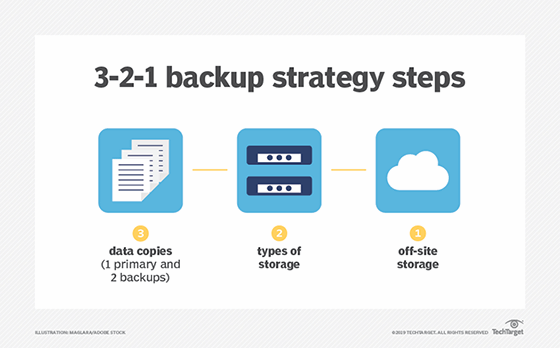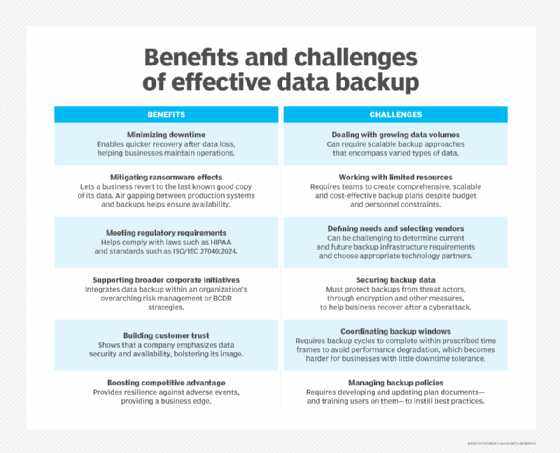12 enterprise data backup challenges and how to overcome them
The virtues of backing up and securing data are well founded, but getting there is no easy feat. Storage capacity, floods of data and infrastructure costs are among the pitfalls.
Data drives decision-making in the modern world. Business leaders rely on data to help them determine where and when to expand to new markets, launch new products, open new locations or, if the going gets tough, close up shop.
Because businesses need data, they must recognize why data backup is important and identify some of the more common data backup challenges. When data is lost or otherwise unavailable -- whether due to a breach, a natural disaster, malicious activity or an honest mistake -- enterprises can pay the price of downtime, noncompliance and lost customer trust.
Data backup and recovery, however, can be difficult as data volume increases, security threats evolve and infrastructure -- on-premises and across clouds -- gets more complex. Businesses benefit from data backup and recovery strategies that emphasize resilience, recovery and flexibility.
Why data backup is important for businesses
The Global Cyber Security (GCS) Network identified three key functions for data backup: protecting from data loss, ensuring regulatory compliance and ensuring business continuity in the event systems go down.
The general rule of thumb for backup is 3-2-1, which suggests businesses keep at least three copies of data on at least two different media types, with at least one copy stored off-site. Businesses can opt to go a couple steps further with the 3-2-1-1-0 rule, which adds one immutable off-site copy and a plan for recovery actions with zero errors. For many organizations, data backup is easier said than done, "mainly because these practices have remained largely static for several innovation cycles … with years of data stored across multiple locations," according to Gartner's 2024 report titled "Build a Foundation for Resilience With Modern Backup and Recovery." The report added that "development and progress in the backup and recovery space have been minimal."

Along those lines, consider some of the more common challenges businesses can encounter when devising, implementing and managing viable data backup procedures.
1. Storage capacity
Enterprises need to be able to predict how their storage needs will increase over time to allocate resources properly and prevent costly overruns. By one metric, McKinsey & Company estimated demand for data center capacity to increase up to 22% annually for the rest of the decade. By 2030, the consultancy expects as much as 65% of data center workloads to be hosted in the cloud, with the remainder hosted privately.
2. Data volume
Complementing the need for capacity is the exponential growth of data generated over the last decade. The problem is exacerbated, according to IDC, when data is sprawled across disparate environments, retained far longer than it's needed for operational or regulatory purposes, and not updated frequently enough to maintain the data's quality and usefulness over time. This presents the dilemma of holding onto data the organization deems valuable versus not holding onto it long enough to incur legal liabilities or operational overload.
3. Infrastructure costs
The days of near-limitless cloud storage might be coming to an end. McKinsey's assessment indicated data center capacity isn't keeping pace with demand due to the increased computing power needs of AI tools as well as supply constraints of electricity and labor. Businesses might have to become investors in data centers or colocation sites to meet their backup needs, McKinsey noted.
4. Physical storage pitfalls
On-premises backups offer an obvious advantage: Businesses can physically see, manage and secure them. Yet local infrastructure can be costly compared to cloud-based options, especially as data volume increases. It's also susceptible to wear and tear that, if unaddressed, can lead to unpredictable failure. Plus, physical backups are of little use if a disaster hits a company's office and systems are taken offline -- or the critical external hard drive is left on someone's desk before the office is shut down.
5. Operating in hybrid environments
Since on-premises and cloud-based data backup options have their shortcomings, enterprises would be wise to take a hybrid approach that can help "yield the most effective and comprehensive backup and recovery strategy," noted Gartner's 2024 report, recognizing the "complexities in managing and securing data across different platforms." Also, data is more distributed, so without greater visibility into what data has been backed up and where, recovery can be a struggle.
6. Technology and policy
Effective data governance and management is primarily about people and culture, said Nigel Turner, principal information management consultant for EMEA at Global Data Strategy. "Getting business and IT people to think differently about data, to recognize its inherent value and agree to take personal responsibility for managing and improving it is the most critical success factor," he explained. That applies to data backup as well. The right technology for the right purpose is important, but so are policies that are well defined, enforceable and reviewed frequently.

7. Compliance
Any enterprise subject to data protection requirements, such as the GDPR or CCPA, needs to ensure sensitive data is made immutable and isolated securely. Additional data types, Gartner noted, are likely subject to compliance requirements related to encryption, mandatory retention or audit trails, especially in heavily regulated industries such as financial services, healthcare and the public sector.
8. Security
Businesses need to keep out attackers, including employees motivated to act against the company's best interests. A range of tools and best practices ensure backups stay secure and accessible. Gartner recommended the integration of multifactor authentication, role-based access controls, and identity and access management with backup architecture, along with ransomware detection and other forms of threat monitoring. If these methods aren't already in place, businesses might have a steep hill to climb to get started.
9. Cloud misconfiguration
Misconfiguration of cloud environments can be especially problematic for data backups. If access controls for cloud services are left unchanged from a default permissive setting, it's unfortunately all too easy for attackers to gain access. Enterprises need to scrutinize their cloud configurations as they make connections to new cloud-based data backups and monitor them frequently to ensure access credentials aren't being abused.
10. Data recovery
A survey by data platform provider Veeam found that 61% of companies can back up large amounts of data within 24 hours, but only 54% can recover lost data that quickly. That kind of lag time can be costly, with consequences that include business downtime, decreased productivity and financial loss. It also leads to stressed-out IT teams. All eyes are on them to quickly make backups available and restore normal operations. Nor is full data recovery guaranteed: A survey by cloud storage platform provider Backblaze reported that only 42% of companies experiencing data loss were able to get all the data back.
11. Use with AI
Workers around the world turn to open source AI tools to assist with everything from predictive analysis to efficiency improvement to product creation. Governance policies are essential to ensure AI tools -- and the employees using them -- access the right data in the proper manner, said Katrina Ingram, CEO and founder of training and consultancy firm Ethically Aligned AI. "Turning a blind eye isn't the right approach," she noted. "You need to decide what to sanction and what to keep off limits, and you need to keep it behind the firewall."
12. Human error
Even the most seasoned and tech-savvy employees can accidentally delete a file, click a seemingly innocuous but malicious link in an email or fall victim to a social engineering attack. Reliable backups restore previous versions of data quickly to mitigate the impact of one user's honest mistake on the entire enterprise.
Strategies for enterprise data backup and recovery
The GCS Network and Gartner offered several tips to help enterprises overcome some of the more common data backup challenges:
- Identify threats to business data. Use the results of this assessment to determine the backup approach that best meets business needs. If considering cloud backup, explore options for multiple locations and service providers for the sake of redundancy and cost management.
- Determine the data sources that require the highest level of protection. Draft immutability and isolation policies to ensure these backups meet compliance requirements and security needs.
- Decide how often data needs to be backed up. Some sources, such as transaction data, might require daily or even hourly backup, while less important data sources can be backed up as infrequently as once a week.
- Devise a plan for recovering from cyberattacks or other types of data loss. Start by assigning a level of criticality to business processes and applications. This approach will influence what data sources are prioritized when turning to backups.
- Consider the role of automation and analytics in data backup. AI, for example, can adjust backup schedules based on data usage patterns, as well as predict capacity issues or other potential points of failure.
- Test data backup architecture regularly. Validate backup files, simulate disaster recovery scenarios and ensure alignment with both compliance requirements and service-level agreements.
Brian Eastwood is a Boston-area freelance writer who has been covering healthcare IT for more than 15 years. He also has experience as a research analyst and content strategist.








